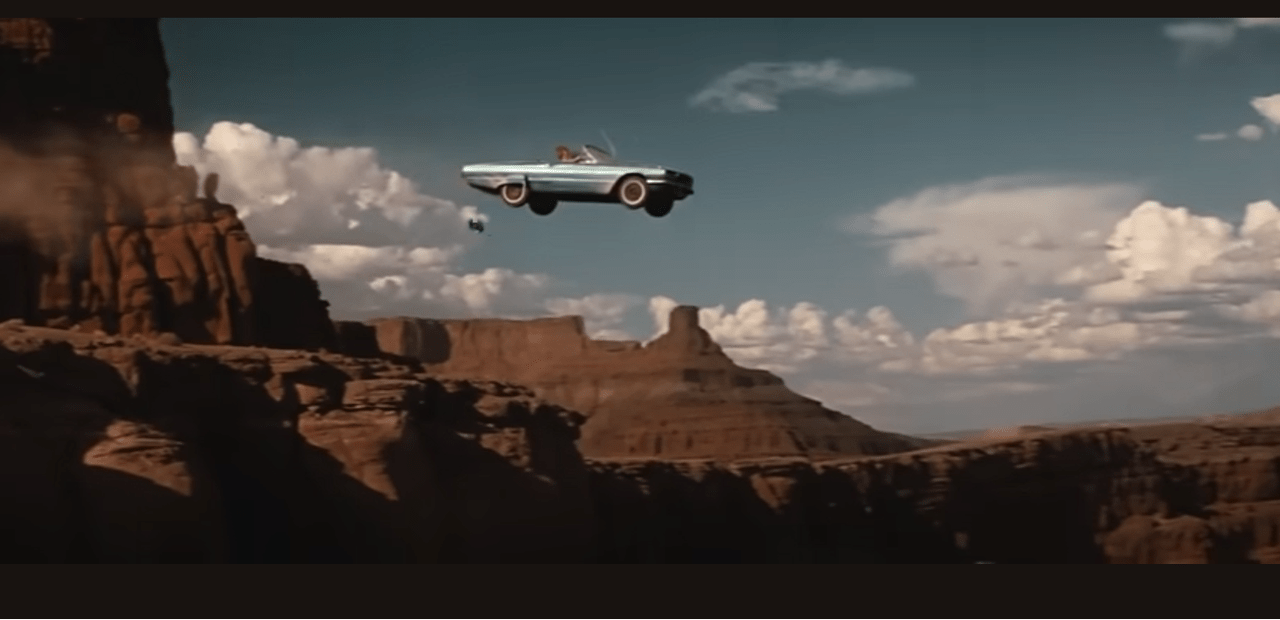
I love this time of year, not just because of the holiday season (and grabbing a few much-needed days off), but because it serves as a period of retrospection for many of us. It’s the perfect opportunity to look back, assess, and hopefully appreciate and learn from the last year – for better and for worse.
It’s also time to look ahead to a new year, an opportunity to temporarily wipe the slate clean and start anew. Resolutions, as we learn over time, are overrated and usually not sustainable. Seldom do we make good on them into February. But at least the ideas of goal-setting and self-improvement are lofty ones. It sure doesn’t hurt to try.
The theme of today’s “Best of” post is a familiar one to JacoBLOG readers: You’re never too old to rock n’ roll. Or buy a second home, purchase that new car, meet a new financial advisor, or take that exotic vacation thousands of miles across the globe. In short, radio’s obsession with 25-54 demos not only runs counter to the natural listening patterns of its core audience. It also limits the medium’s growth potential at a time when we should be looking for revenue anywhere and everywhere.
If radio is to finally have a recovery year in 2025, its ownership is going to have to think differently about many things, including who its biggest and best audience is and should be.
And so we start the new year with this post that ran last June. – FJ
Is It Time For Radio Broadcasters To “Thelma & Louise” Over The Demographic Cliff?
June 10, 2024
When you’ve signed on as many radio stations as I have, you become very accustomed to appreciating the push and pull of risk and reward. I’ve had the good fortune to be involved with numerous winners, some of which were absolute long shots. And those are the ones you truly enjoy when they succeed.
As a result of our foray with Classic Rock in the ’80s, followed by the Edge format through much of the ’90s, I’ve had the unique thrill of creating new formats and innovating tired ones. I’ve experienced more sales meetings than you can imagine, filled with pessimistic reps sitting there with their arms crossed.
Like Z100’s famous “From worst to first,” getting behind an underdog and watching it defy all the naysayers – and radio is famous for having lots of naysayers – is pure joy. Unfortunately, as much as our industry has historically claimed to always be looking for “the next big thing,” skeptics often outnumber optimists when it comes time to press the trigger.
In the past, launching new radio formats was simply a smart, evolutionary idea. In much the same way the auto industry has always come up with new makes and models of cars and trucks, broadcast radio at least here in the U.S. consistently hatched new variants of old formats or created new concepts altogether. They didn’t always work, of course, but the consistent search for new and different radio was always omnipresent.
But outside of the typical new format launch, when is it time to take a real risk – the kind that can turn out to be a career do-or-die? I’m talking about a serious roll of the dice, because nothing else seems to be working – the moment born out of a combination of desperation but also a sense of adventure?
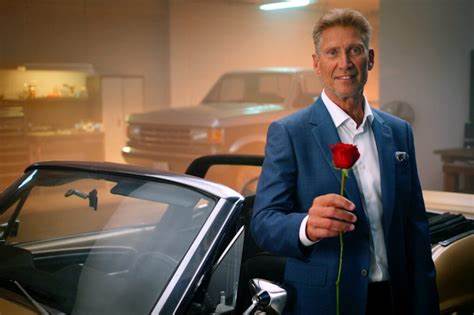
That’s apparently the point commercial television is reaching, and we radio folk should be paying attention. I don’t watch a whole lot of network prime time – obviously, I’m part of the problem, too – but the signs have been there for a while. A lot of shows have had an AARP-ish sheen to them for a long time, led by old salts from Tom Selleck to Mark Harmon. And then the Golden Bachelor, last year’s moon shot by ABC that ended up coming up roses. Not only did this reality TV drama work for Baby Boomers, younger generations lurked, too, making the show a rare network TV success.
And now there are strong indications the networks have assessed their increasingly precarious situation, and they’re ready to Thelma-and-Louise over the vast demographic cliff – yes, the same vast abyss radio’s been flirting with or well more than a decade.
A recent story in the Wall Street Journal was the clarifier for me. Titled “TV Networks Embrace Their Aging Audience With a New Mantra: Age Doesn’t Matter,” it contains quote after quote from network executives indicating the bleeding has finally gotten to the point where a complete rethink of the givens hasn’t become just a good idea – it’s a necessity.
The sub-headline is every bit as good: “With viewers in their 60s, networks aren’t pretending to have youth appeal; they’re outing the virtues of older audiences.” Sound familiar, radio peeps?
Writers Isabella Simonetti and Joe Flint did the legwork for WSJ, cataloguing one assessment after another that justifies the shift to viewers of a certain age, rather than cater to a younger audience that has simply gotten away from them. They point to an “upfront” from Warner Brothers Discovery that touted the “broad audience” marketers can’t get anywhere else in “a trusted environment,” of course.
And the gnarly question of age was avoided at the event, as networks are gravitating away from the tried-and-true demographic pitch in favor of consumer brand preferences and purchasing patterns and tendencies.
For these traditional bastions of television viewing, marketers are now pitching reach (how novel – the biggest numbers on the page, by the way), and the fact consumers will simply buy the advertised product or service, regardless of their chronological age.
After all, network TV demographics look awfully familiar to what we’ve become accustomed to seeing in radio ratings over the past many years. And without more creative, innovative digital content and the marketing to support it, how likely is that to change?
Consider the median age of network audiences, including a long-in-the-tooth MTV, clocking in at 51 years of age. Even Beavis and Butthead have joined AARP.
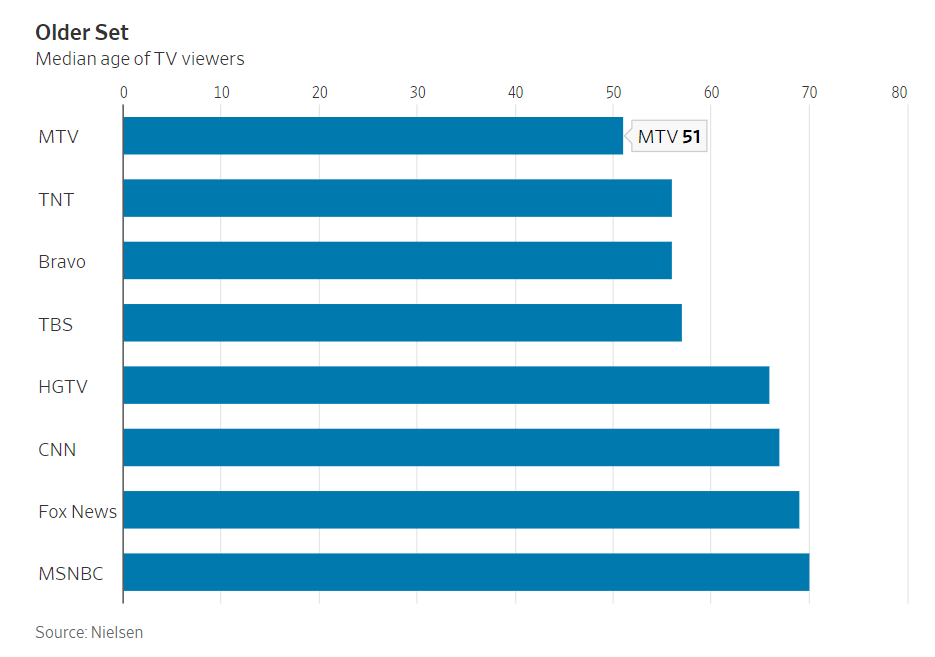
As Simonetti and Flint point out, the TV networks have one simple, unified goal:
“Make the most of the…audience they do have – and cushion the financial blow of the industry’s decline.”
Now that wasn’t so hard, was it? Sure, it stings a bit, but being pragmatic and owning your situation is part of the strategic process.
Network marketers are also studying lifestyle changes, making the point that “65 is the new 50” when it comes to purchasing power and the inclination to use it. While everyone was pulling back during COVID, a recent report from the Video Advertising Bureau reveals household income of U.S. adults 65 and older actually rose 7% between 2017 and 2023.
The consensus is shifting (as things often do in Ad World). Now, the mantra is that demographic targeting is antiquated and confining. Now, it’s about prospects who will purchase, regardless of the age on their passports and drivers’ licenses.
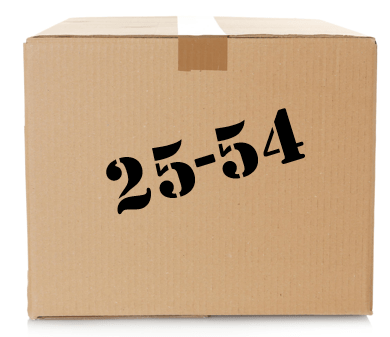 Mark Marshall, NBCUniversal’s chairman of advertising and partnerships, put a point on it that should resonate with radio professionals:
Mark Marshall, NBCUniversal’s chairman of advertising and partnerships, put a point on it that should resonate with radio professionals:
“For decades, we have transacted on age and gender, like adults 25 to 54, as if everyone in this whole segment is the same person buying the same products at the same time.”
Rita Ferro, Disney’s president of global advertising, commented on these typical targeting segments:
“It’s a dated way of even talking about audiences across our media landscape.”
So, there you go, radio community. Some very big names and smart people are weighing in on the limitations of demographic targeting, just in time for broadcast radio where the aging process is in full bloom.
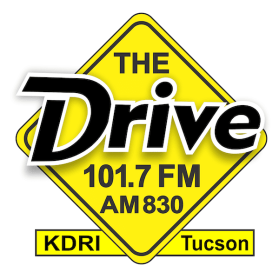 Now, the television industry is giving radio cover to jump on this marketing life raft. A handful of radio swashbucklers have done just that. Recently, Sean Ross highlighted Bobby Rich’s Drive in Tucson, along with John Sebastian’s Wow Factor in Phoenix. (Obviously, Arizona is a target rich environment for 55+ radio listeners – and their wallets and purses).
Now, the television industry is giving radio cover to jump on this marketing life raft. A handful of radio swashbucklers have done just that. Recently, Sean Ross highlighted Bobby Rich’s Drive in Tucson, along with John Sebastian’s Wow Factor in Phoenix. (Obviously, Arizona is a target rich environment for 55+ radio listeners – and their wallets and purses).
I think back to the way my Classic Rock format architecture sounded in the early-mid ’80s, and it had some of the same eclectic elements – the British Invasion meets ’70s soft rock meets a little Motown.
My version was more rock-centric (the Kinks in favor of Billy Joe Royal; Crosby, Stills, & Nash rather than B.J. Thomas). The net effect would be the same; box car numbers among 55+ listeners, with an easy win over everyone else in the 35-64 year-old market. Heck, many Classic Rock stations are already hitting it out of the park in this demo, without even trying.
Clearly, conditions on the ground are changing. At what point do broadcasters find a sales person or two who actually understand and embrace the concept, rather than whining about a lack of Millennial listeners?

Far be it from me to suggest a Thelma & Louise adventure into radio oblivion. But there is a lot to be said for a “go for it” approach already justified by broadcast radio’s natural appeal in the gray area.
And you never know. A bona fide effort to embrace radio’s seniors might shake up the bottom line, open up new possibilities for radio in virtually every market, and give the industry the enema it needs.
You never know – we might bypass the “demographic cliff” altogether, and end up in the green.
Oh wow.
- Who’s Got It Better? Talent In Commercial Radio vs. Talent in Christian Music Radio - June 4, 2025
- It’s The Christian (Radio) Thing To Do - June 3, 2025
- Is It Time For Radio to WAKE UP?! - June 1, 2025





Missed this blogpost earlier…but yes…“Make the most of the…audience they do have – and cushion the financial blow of the industry’s decline.” This should be radio’s mantra until it isn’t. And unfortunately – it’s not…at least on the broadcast side…
Remember the monster 12+ numbers delivered by “Standards” stations back in the day? Well, now, the entire industry has moved up the demographic ladder. Back then, there were many examples of stations who dedicated their sales efforts to selling that audience. Being on the Network/Syndication side for so long, I saw it every day with Music of Your Life and other similar Formats. Now, that 25-44 audience we nurtured in the 80’s-90’s are there and have no OTA music based stations to embrace. I see our BNW customers making sure their SXM Radios are working so they can hear the 60’s, 70’s 80’s and classic Country channels. But we need to learn to sell that audience at the local level, since advertisers are and will always be tied to 25-54. Until that happens, so long 55+ audience.
I’d posit the same holds true for any marketing effort regarding the
playing to those who grew up with “standards”, “beautiful music”, and later, “smooth jazz”. I point to today’s lack of any sort of broadcast service regarding truly contemporary Easy Listening or “chill music”, if you will. Broadcasters have missed the point and opportunity, that is to provide a format/approach that provides the listener a companion service to relax, unwind and chill from the day’s events, news, struggles, etc. We humans need time to decompress and contemplate the day’s events to figure out those decisions to guide our lives. Radio once provided this service. Today’s AC passes for easy listening, yet it is still a nervous, demanding our attention, “listen here and now” approach, not a relaxing “matter-of-fact” soundtrack at all. And I and many get that “E-Z” soundtrack flow from DSPs. NAC/Smooth Jazz provided that unique modern background/foreground-passive/active listening experience, until it was no longer PPM-friendly, and thus destroyed. (And active listeners purchased physical product.) The difference being I “hear” it passively, or I “listen” to it actively. Now, classic rock/classic hits, et al, occupy that realm-yet still too nervous for most seeking solace and easing up the day after a long day’s stress. In not serving the 55+ audience, radio loses the many at the expense of catering to the PPM/diary few. And never mind the revenue left on the table. FWIW
What I said earlier applies. Even “unwinding” formats have to get enough ad support to pay the bills. We’re still a business, and the ad agencies aren’t supporting the 55+ demo in radio.
That — and nothing else — explains the demise of those formats you are championing. Absent sufficient ad revenue, they are all non-starters now.
The revenue “left on the table” is there because there isn’t enough of it at the local level to sustain operations.
I get the impression from reading your long-winded argument that either you have never been in the business or if you were that no one ever explained this to you.
Phil, i worry no one is even the least bit interested in marketing 12+, much less 55+. The audience is aging, but radio’s target demographic is stuck. Thanks for commenting.
I’ll tell you the way Don Davis, the owner of KRKE in Albuquerque, the “flagship” station of my Classic Hits format The Eighties Channel™ sells it (and we were at the maximum spot load we designed the hot clocks for all through December, and are only down by about 25-30% post-holiday):
A lot of local businesses that cater to a 55+ audience are owned by people in the same demo. What Don does is start by describing the format in terms of our core artists … which resonate with the prospect. He calls it the “elevator conversation” because it takes about as long as a pitch delivered between floors while riding in one.
He says that about 85% of the time, that’s enough to close the sale. If it doesn’t, he invites the prospect to listen for a few days and then he calls them back. That listening experience is enough to close all but a handful of sales.
Never mind Nielsen ..,. the most important rating you get is with the advertisers. If they like what they hear, their mindset becomes “others who also like this station would be good customers for me”.
The only question we need to ask ourselves is … are we programming a station sound that appeals BOTH to the listeners AND the advertisers? They are both in the same demo, and when you please one you please the other, because the listeners DO become good customers.
We know Madison Ave. is going to take forever to realize that the same audience that watches “The Golden Bachelor” also listen to radio stations with classic formats, be it Rock, Hits, or Country. But we have the advantage there when it comes to local sales, because the business owners are positioned, age-wise, to be on our side.